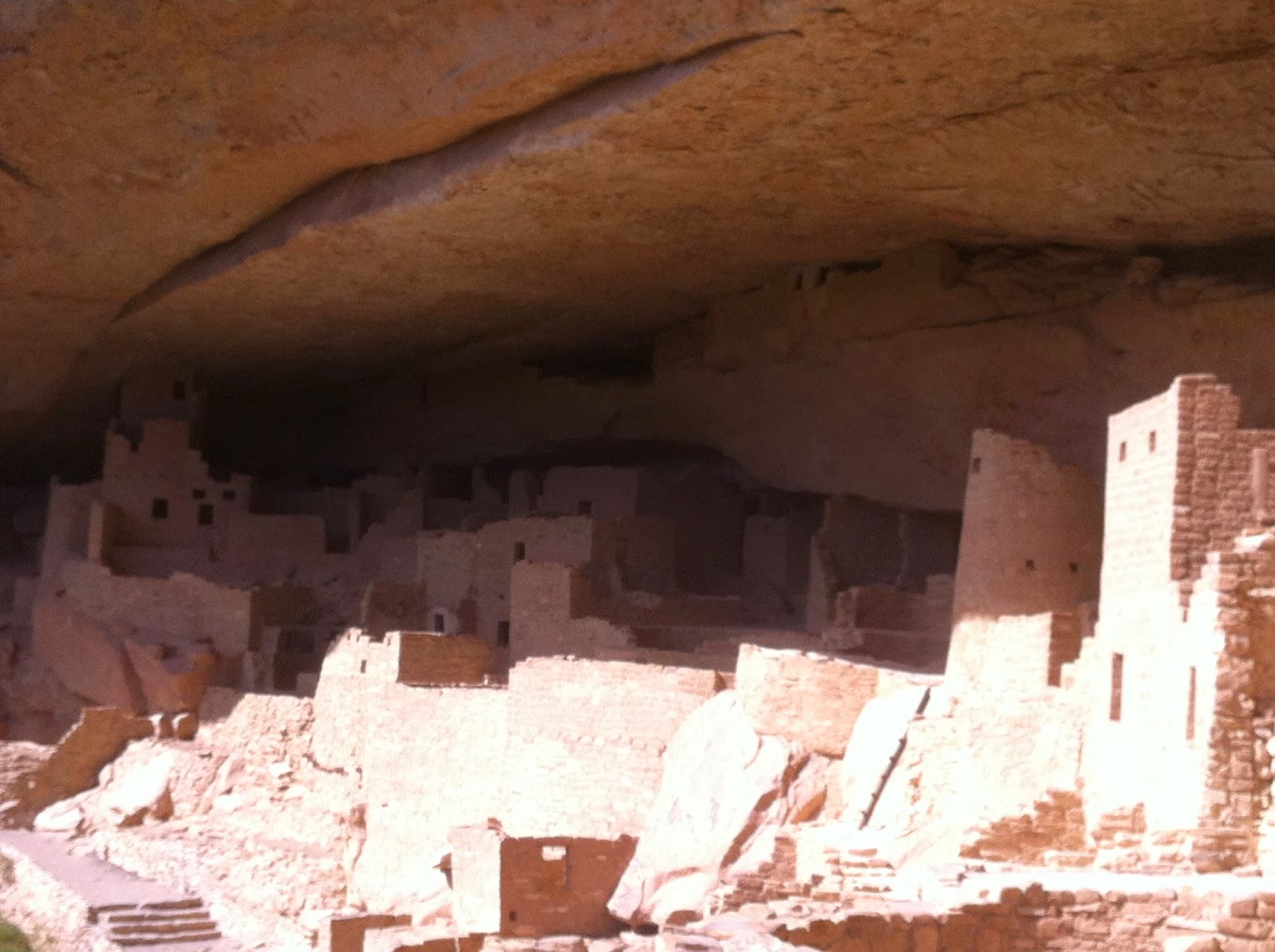After leaving the Four Corners area, we continued into Colorado for the first time during our excursion. We also saw rain, a brief 10-15 minute shower, for the first time in 2 months, since extreme east Texas. Shortly thereafter it cleared off as we were pulling into Mesa Verde National Park just outside Cortez, CO. If you take nothing else from this post, be certain that if you are ever within a 250-mile radius of Mesa Verde NP, don't miss it.

Mesa Verde is known for its vast collection of Ancestral Pueblo cliff dwellings, including the largest and most elaborate cliff dwelling discovered in the US, "Cliff Palace."
Some of the cliff dwellings are free to be explored on a self-guided tour, others require (very reasonably priced at $4.00 each) tickets for timed tours with NPS rangers, and others require extremely long and strenuous hikes to reach but can be viewed from various viewpoints throughout the park.
Upon reaching the park, we first purchased tickets for the Cliff Palace tour and started the nearly hour-long drive into the heart of the park where the dwellings are located. Following a brief lunch in our van, we met up with our NPS ranger tour guide at the Cliff Palace Overlook to begin our tour. We were very lucky as for whatever reason, there was a lull in the visitors touring for our 3:30 tour; there were only 6 people in our tour group and the tours both before and after ours had 30+ visitors each.
The photo below is from the Cliff Palace Overlook, looking into the alcove in which the dwelling is situated.

Cliff Palace was "first discovered by Anglo-European cowboys" in 1888; prior to that it was known, located on land owned by, and mostly avoided by Ute tribe Native Americans due to their desire not to disquiet any spirits that may reside within. What a sight it must have been to stumble upon this magnificent castle-like structure while searching for lost cattle in the 1880's.

Use of scientific dating methods and dendochronology, it has been determined that this small city was built and inhabited from approximately 1190AD - 1280AD. After that time the structure was abandoned and never used again, perhaps due to extreme drought in the area, difficulty cultivating food, or other unknown reasons. The dwellings remained known to Ute and other natives in the area, but were never re-inhabited, remaining vacant for nearly 850 years.


A shot of the canyon in which Cliff Palace is located.

Across the canyon from Cliff Palace other much smaller dwellings are sprinkled throughout the canyon side.

Descending into the canyon with the Ranger, the structures can be examined much more closely.

While some of the structures have been reconstructed, a majority of the structures remains original, simply having the debris, rock, and rubble that began to envelop the dwelling removed.





Seep springs flowing out of the surrounding rock walls provide some water, while grain storage units were constructed in the highest and deepest crevices of the alcoves to prevent rot and rodent infestation.







Cliff Palace is truly one of the most remarkable cultural sites in the US, and is definitely worth visiting if on a trip to the Rockies or southwest US.

Another Ancestral Puebloan cliff dwelling that is available for self-touring at Mesa Verde is Spruce Tree House. While not as large as Cliff Palace, it is still a remarkably well-developed settlement.

The round structures are the ceremonial Kivas, a structure central to all of the Ancestral Puebloan settlements through the Southwest.













Spruce Tree House viewed from the top of the canyon trail prior to descending to the dwelling.



Elsewhere in Mesa Verde NP are examples of excavated Pithouses, in which the Anasazi natives lived prior to evolving to their lifestyle of residing in the apartment-like cliff dwellings. The pithouses, as the name implies, are dwellings excavated partially into the earth, with roofs supported by four poles, covered by small logs or branches serving as trusses, and the entire structure covered by earthen mud and sandstone dust to create a cement-like structure. Viewed from the outside, they appeared as earthen mounds with a hole in the top center for ingress/egress (served by a ladder) and for smoke to escape. They had a vent hole so the internal fire pits would "draw" correctly and evacuate smoke through the top hole. It has been determined through archaeological research that a vast majority of pithouses burned, perhaps driving the natives to seek an alternative type of domicile such as the cliff dwelling.

The cliff dwelling below, named Square Tower House, contains the tallest structure within the park, the nearly 90-foot tower which can be easily seen in the photos.


More early Pithouse excavations in the photos below.


Cliff dwellings large and small are interspersed in the canyon walls throughout the park. It is obvious the dwellings collectively composed a fairly large and advanced community.










The Sun Temple is unlike any other structure within the park; construction was started but never completed. It is built in a very recognizable but uncharacteristic D-shape, and has no doors or other easy means of ingress/egress, meaning it was likely never designed for domestic use. More likely, archaeologists believe, it was constructed for religious or spiritual use, perhaps in one final plea to the spirit gods possibly to reverse the fortunes of the failing civilization. It is believed an at least 23-year drought plagued the area near the end of the natives' inhabitation of this area, and Sun Temple may have been constructed, but never finished, prior to the evacuation of the area.




View from the Mesa Top Loop, around 9,000 feet MSL.

That evening we located a campsite just a mile or two from the entrance to Mesa Verde on BLM land, and when scouting the area surrounding our campsite, we located this intact carcass, most likely from a deer.

No comments:
Post a Comment